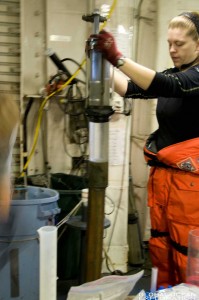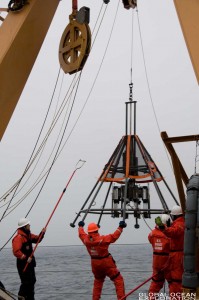I have spent the past two days learning about the multi-core, a state of the art benthic (sea floor) sampling device. The multi-core is unique in its ability to preserve the sediment water interface while sampling. This is a critical zone for the exchange solutes between the bottom and the water. Nutrients, dissolved gases, and other elements collect in the bottom sediments and their interaction with the water above is one important element of the research being conducted by the researchers on this cruise.Â

Paul Walczak, the coring guru, prepares the multi-core for deployment.Â
Â
Dr. David Shull from Western Washington University and Dr. Al Devol from the University of Washington lead the team along with their graduate students Emily Davenport and Heather Whitney. They are studying how the sea ice and its melting are affecting the processes on the sea floor, specifically where the organic matter accumulates and the effects that the burrowing animals, such as tube worms and clams, have on the nutrient supply to the overlying water. They use the multi-core instrument to collect their samples which they then analyze to get profiles of nutrients within the layers of the sediment. They measure nitrate, nitrite, ammonium and nitrogen gas, key components of the nitrogen cycle, to learn about the nitrogen levels in the sediment along with oxygen, silicate, phosphate and radon which Dr. Shull refers to as the “magic gas.â€Â
By collecting the information about the gases and nutrients, the researchers hope to unravel the mystery of how the ice melt and presence of more organic matter in the water column affects what is on the sea floor. Will a larger food supply from increased ice melt and the following increase in mud-dwelling organisms increase or decrease the amount of nitrogen in the water just about the sea floor? These are the big questions that this group of scientists are trying to answer. Â
Why is this important? The Bering Sea has a remarkably productive benthic system. From clams and tubeworms to King Crab and Pollock, the exchange of nutrients from the bottom to the waters above is a key component to the food web. It is important to understand what are the limiting nutrients in the Bering Sea and how they affect ecosystem structure. Looking at what is in the water column and what ends up on the bottom and how it interacts with the sediments and its eventual return to the water column is of vital importance to our understanding of exactly what is happening here. In our world of climate change, the effects that more or less ice will have on the system is of vital importance to gaining insight into what the consequences of changes in the ice will have on the entire system in the future.Â
  Â
Bringing the multi-core back on board after collecting sediment cores at 3500 meters below. The winch and A-frame do most of the work but the crew on deck must guide it in gently to not disturb the samples or damage the instrument.
Â
The multi-core can take up to eight samples each deployment.  A good sample has clear water on top of the sediment and the interface between the sediment and the water should be undisturbed.
Â

Dave Shull examines a core. This is a good sample as the water above the sediment is clear.
Â

Heather Whitney takes samples from the core to process later. The core is carefully sliced in order to sample the various layers of the sediment.
Â

Emily Davenport gets ready to extrude the core from the sampling container in order to begin sampling.Â
Â

A core is sampled for oxygen using a specialized probe that records data and gives a profile of oxygen concentration in the core.Â
Â


